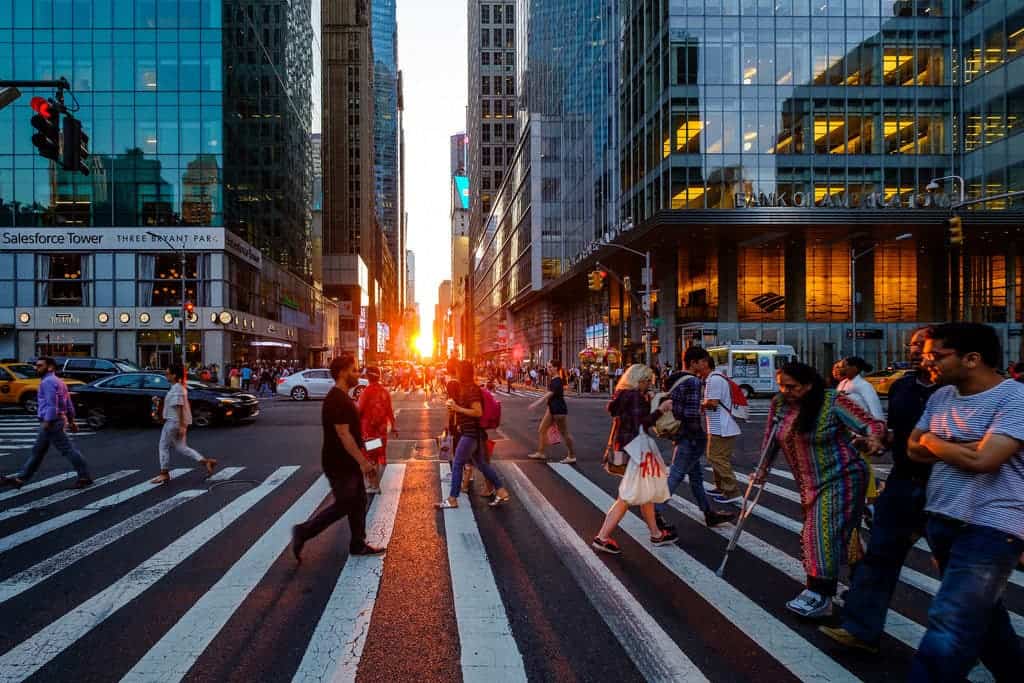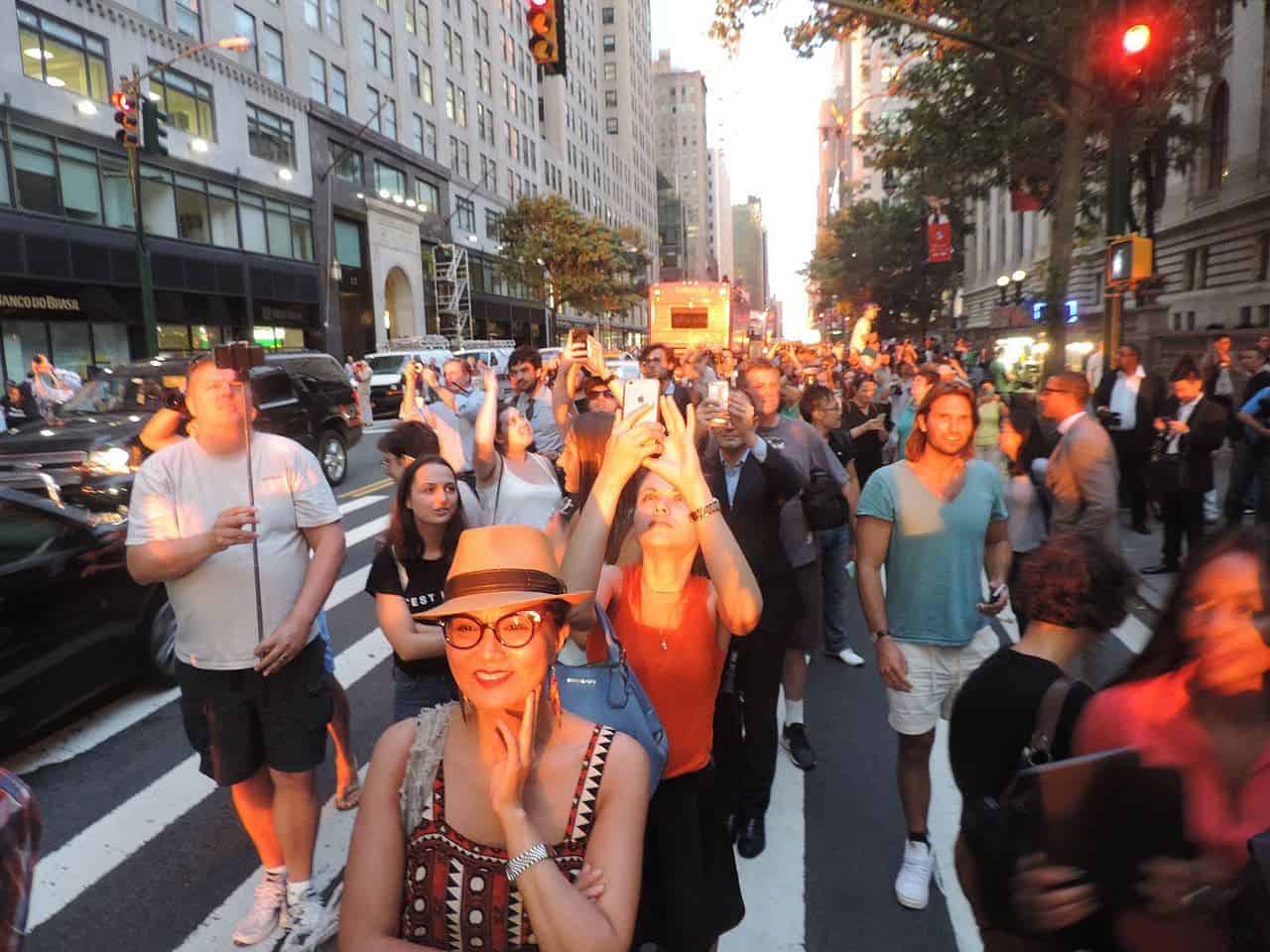Four times a year, the east-west streets of Manhattan align with the rising (or setting) Sun — around May 28, July 13, December 5 and January 8. The phenomenon is called Manhattanhenge.

What is Manhattanhenge
The purpose and usage of Stonehenge are still not fully understood. However, most archaeologists believe that it was used to track the time of year, since some of the rocks are aligned to the sunset of the winter solstice and the opposing sunrise of the summer solstice — and believe it or not, Manhattan can serve a similar function through its street design.
It’s a peculiar sight, one of the few astronomical phenomena which can be witnessed in the heavily-polluted New York City. Four times a year, the setting (or rising) sun aligns with the city’s perpendicular streets — two times for the rising sun, and two times for the setting sun. Here’s why this happens — be advised, things may get a bit technical.
According to plans developed in the early 19th century, Manhattan’s streets are built on a generally perpendicular grid — not directly on the east-west, but rather at an angle of 29° clockwise from the east-west line. This is the first required ingredient: perpendicular streets. The second ingredient has to do with how the Earth moves around the sun.
They say the sun rises in the east and sets in the west — but that’s more of a rule of thumb than an exact statement. A more precise way to put it is “The sun rises in a generally eastern direction and sets in a generally western direction” — it only rises exactly in the East and sets exactly in the West on two days every year, during the spring and fall equinoxes (when the daytime is exactly equal to night time).
After the equinox, the sun’s path gradually drifts northward and southward respectively. For instance, by the June solstice (usually June 21), the sun rises considerably north of due east and sets considerably south of due west. For mid-northern observers, the noon sun is still toward the south, but much higher in the sky than at the equinoxes. This happens because the Earth isn’t perfectly aligned with the sun: it has an axial tilt of approximately 23 degrees.

So as the sunrise-sunset direction changes its alignment, it happens to coincide with the alignment of Manhattan’s streets. There’s no magic or spectacular astronomical phenomenon involved, it’s just a coincidence. Think of the old saying: even a broken watch is right twice a day — the same thing is happening here. Two times for sunrise and two times for sunset, the solar alignment happens to coincide with the street grid. Voilà, Manhattanhenge!
Seeing Manhattanhenge
The date in which Manhattanhenge takes place varies slightly every year. The precise date depends on the summer solstice, which varies from year to year but generally takes place around June 21. You can see the aligned setting sun two times, evenly spaced around the summer solstice. For instance, in 2014, the “full sun” Manhattanhenge occurred on May 30 at 8:18 p.m., and on July 11 at 8:24 p.m.
Similarly, the dates in which the sunrise aligns with the Manhattan grid are evenly spaced around the winter solstice, which approximately corresponds to December 5 and January 8.
Of course, in order to be able to witness this phenomenon, the sky needs to be at least partly clear so you can see the sun.
Here’s a table of the previous dates. Here, “full sun” means that the full solar disk is just above the horizon, and “half sun” means that the solar disk is partially hidden below the horizon (due to the time of day when the phenomenon takes place, the sun can be partly set or partly unrisen).
| Date | Time | Type |
|---|---|---|
| May 29, 2016 | 8:12 p.m. | Half sun |
| May 30, 2016 | 8:12 p.m. | Full sun |
| July 11, 2016 | 8:20 p.m. | Full sun |
| July 12, 2016 | 8:20 p.m. | Half sun |
| May 29, 2017 | 8:13 p.m. | Half sun |
| May 30, 2017 | 8:12 p.m. | Full sun |
| July 12, 2017 | 8:20 p.m. | Full sun |
| July 13, 2017 | 8:21 p.m. | Half sun |
| May 29, 2018 | 8:13 p.m. | Half sun |
| May 30, 2018 | 8:12 p.m. | Full sun |
| July 12, 2018 | 8:20 p.m. | Full sun |
| July 13, 2018 | 8:21 p.m. | Half sun |
The 2019 dates for Manhattanhenge are:
- Wednesday, May 29th at 8:13 p.m. EDT (half sun);
- Thursday, May 30th at 8:12 p.m. EDT (full sun);
- Thursday, July 11th at 8:20 p.m. EDT (full sun);
- and Friday, July 12th at 8:21 p.m. EDT (half sun).
Some streets are better suited for the phenomenon than others. For the best results to see Manhattanhenge, you should go east as possible. For instance, the Empire State building and the Chrysler building offer particularly striking views.
The folks at CartoDB have made an interactive map which you can check for yourself to see what streets perfectly align with the sunset of Manhattanhenge.
Other-City-henge
As you might expect by now, Manhattan isn’t the only place you can witness this phenomenon. Essentially, if the weather is fine enough, you can see a Manhattanhenge-like phenomenon in any city with perpendicular streets. The date at which the phenomenon happens depends on the alignment of the streets — their angle compared to the east-west line.
You might have to calculate the date yourself, though there’s a good chance you will be able to find it already online.

As a general rule, cities in the US are more likely to have perpendicular streets than cities in Europe, for example, though there are exceptions (such as Barcelona).
In Baltimore, for instance, the two dates of the “Baltimorehenge” sunrise are around March 25 and September 18, while the sunset dates tend to fall on March 12 and September 29. In Chicago, the setting sun lines up with the street grid around March 20 and September 25, a phenomenon dubbed Chicagohenge.
A few other cities where this type of phenomena takes place are Toronto, Montreal, Cambridge (Massachusetts) and the UK’s Milton Keynes.
It’s rare to be able to enjoy a special astronomical phenomenon, let alone a modern one — so if you get a chance to see a Manhattanhenge or some-other-city-henge, be sure to take lots of photos and feel free to share them with the rest of us in the comment section.



